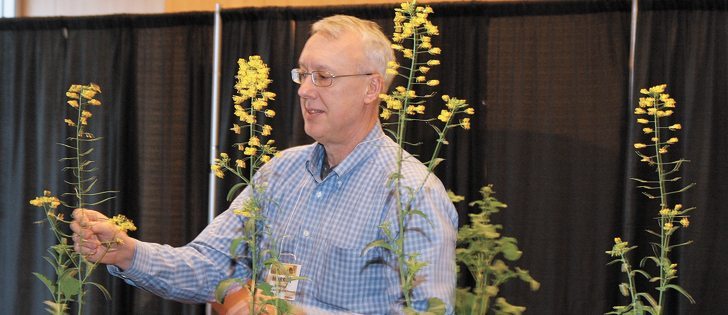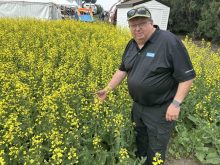Canola growers have hormones to thank for last year’s unexpectedly good yields, says an oilseed expert.
The hierarchy of reproduction in a canola plant places priority on the first seeds that are set in the plant.
“They send a hormone signal to the later developing seeds that they are number one,” Murray Hartman, the provincial oilseed specialist with Alberta Agriculture, said in an interview following his presentation at the 2016 canoLab workshop.
“That’s why pods get smaller, and there are fewer seeds later on.”
However, when nature upsets the pod development process, it also disrupts the hierarchy and the hormone balance in the plant.
“All of the sudden you will have a chance for later pods to get bigger and more seed,” he said.
That’s what happened last year. The crop was stressed in May and June and then rain fell in July, which helped it recover better than most farmers anticipated.
Statistics Canada’s initial estimate of the crop was 13.3 million tonnes, but the latest estimate is 17.2 million tonnes.
“In Alberta, we had six or seven counties that were written off in June and early July because of drought,” Hartman told the workshop. “They ended up with average yields.”
Canola initially reacts poorly to stress. Plants may take one week to overcome two days of heat stress, during which pod production is dismal.
Read Also

Crop conditions a pleasant surprise
Market analysts found some stressed crops and some good ones on pre-Ag In Motion 2025 crop tours,
However, it is much better at recovering from stress than wheat.
“I often call canola a teenager and the cereal an adult because of their response to stress,” said Hartman. “Even though it’s kind of a disadvantage that it responds so badly to a short period of stress, when it does recover, all of the sudden it has so much ability to grow new buds and clusters from the axis of branches.”
Heat is one of the biggest stresses for canola.
Hartman has reviewed studies suggesting it starts between 22 C and 35 C, but a lot of them used flawed methodology.
He said it typically happens at 27 C to 28 C, and more damage will occur when nighttime temperatures following the period of heat stress exceed 16 C.
It’s why heat stress damage is typically lower in Alberta than in eastern Saskatchewan and Manitoba, where nighttime temperatures often do not drop below 20 C following hot days.
Hartman urged growers to scout their fields during the early flowering stage because the size of the petals, the colour of the petals and the stamen tell a lot about how the crop is faring.
For example, pale, small petals and normal stamen means the plant likely suffers from sulfur deficiency. Pale, normal-sized petals and short stamen probably means glyphosate damage.
Hartman said there are 10 conditions that can be diagnosed by looking at all three aspects of the flowers.
Unfortunately, many farmers tend to look down at weeds instead of up at the flowers when scouting their fields.
A farmer might not be able to do anything about something like heat stress, but a proper diagnosis could save him the expense of top-dressing the crop with fertilizer when it is not a nutrient deficiency problem.
“You can stop yourself from doing something stupid,” he said.


















